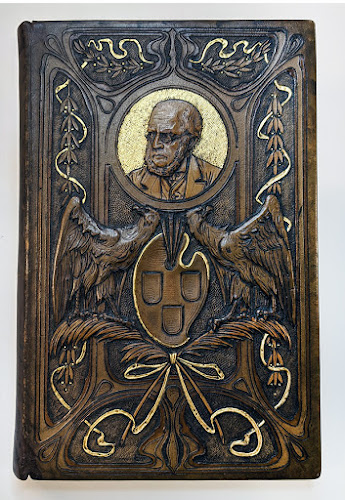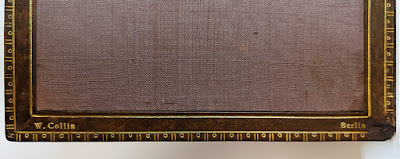Today, on Ernst Collin's birthday, I once again share an overview of findings from the past year. For a variety of reasons, things have slowed down around this blog and my ongoing research around Ernst and his family of W. Collin. Reasons include the copyright "wall" that is moving forward a year at a time, but also less time and energy on my part. We'll call it burn out that affects much more than this work. That said, there were some exciting moments. That said, almost none of what I have found and learned would have been possible without digitized collections such as HathiTrust and the Deutsche Digitale Bibliothek.
My article 'Ernst Collin und sein Pressbengel: Eine Spurensuche zum Buchbinder, Schriftsteller, Antiquar und Bibliophilen' appeared in the Marginalien of the Pirckheimer Gesellschaft, a German bibliophilic organization originally based in Berlin. With this article, I formally reintroduced Ernst Collin and his family to those they bound for, and he wrote for. The article also shared some findings "discovered" since Die Collins / The Collins appeared in 2016.
 |
| Opening spread of the article. On the right Ernst Collin's exlibris by Walter Kampmann. The exlibris was included in the first volume of Die Heftlade. |
We know that Ernst Collin wrote for a very wide range of publications, so I was not surprised by the advertising leaflet for Dornemann I found bound in with several Paul Kersten texts on finishing and tooling that someone had compiled. Also bound in were several more leaflets for Dornemann by Kersten. These kinds of things are rather ephemeral, and I was not able to find the ones I have in the catalog of the German National Library, that has a large collection. Dornemann was one of the largest manufacturers of brass finishing tools and type in Germany, and the pallets and gouges I have were made by them.
 |
| Brass type for the hand-finisher. [n.d.] |
However, most of all, I was absolutely surprised to have discovered a copy of the deluxe edition of Ernst's Pressbengel bound in parchment when I really wasn't looking. Ordered and now in my collection of the editions of this work. There were a total of 30 copies of the deluxe that could be ordered in parchment or leather, bindings by Hübel & Denck, Leipzig.
 |
| Printed in Didot-Antiqua onto VERY heavy/stiff Zanders ragpaper. This is number 7. Sadly, they weren't signed. |
We'll see if a copy of the deluxe in leather ever appears on my screen...
I also continue to find reference to the Pressbengel, Die Heftlade, and Paul Kersten by Ernst Collin in book trade publications. Below a listing from September 23, 1922 for the Pressbengel in the Wöchentliches Verzeichnis der erschienenen und der vorbereiteten Neuigkeiten des deutschen Buchhandels published by the Deutsche Bücherei. The Wöchentliches Verzeichnis indicated new publications. There was also a review in the Börsenblatt für den deutschen Buchhandel, 30 October, 1922.
 |
| Note the prices. This was still relatively early in the period of hyperinflation. These prices would have reflected the values in the paper money of the time... |
Just recently I came across a website with a free download of "The Bone Folder" by Ernst Collin. A very readable little book, it was first published in 1922 and takes the form of a conversation between a book lover and a bookbinder. The imposition has already been done, and it folds into five sections. It would make a nice little project for members who have completed our basic course. I have run off some extra labels if anyone would like to bind up their own copy. The website where it can be found is https://pressbengel.blogspot.com/.
Downloading another article from HathiTrust, I was very pleased to discover that a W. Collin binding I have was depicted in Deutsche Einbandkunst im ersten Jahrzehnt des zwanzigsten Jahrhunderts by the great German bibliophile and author of the time G.A.E. Bogeng.
 |
| W. Collin binding on Adolf von Menzel. |
My work around Ernst Collin and W. Collin was also an integral part of my talk, Down the Rabbit Hole: Embracing experience and serendipity in a life of research, binding practice, and publishing, given to the William Anthony Conservation Lecture series at the University of Iowa on September 30th, 2021. The Collins were one of the three rabbit holes I discussed, one I am still glad to be lost in.
Finally, while not technically citing Die Collins / The Collins or this blog, I was glad to see both included with paraphrasing, images, and the references of the Tagebuch der Buchbinderei und Druckweiterverarbeitung (Band 4, 19. Jahrhundert) that was compiled by Hans Joachim Laue. The self-published volume presents events in the history of bookbinding and the book trades with an entry per day. I look forward to Band 5, the 20th century.
My to-do list includes entering many of these references into my database of Ernst Collin's writings...

























